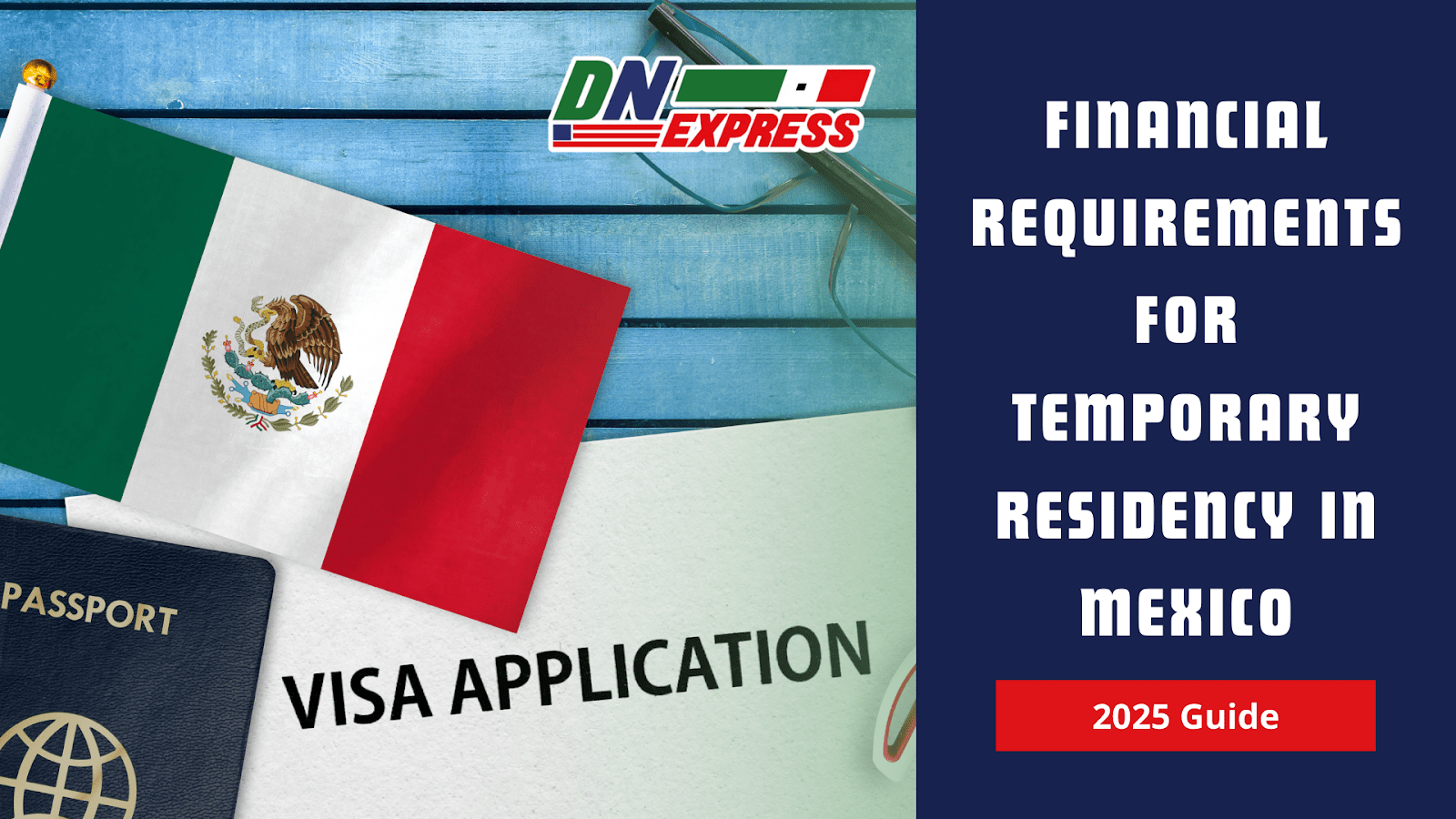
Wondering how much money you need for a Mexican temporary residency visa?
In 2025, most applicants must show monthly income ($4,185 USD) or savings ($69,750 USD) for 12 months.
Requirements vary by consulate, situation, and method. Here’s what you need to know to qualify. But not every case is the same.
Financial thresholds can shift based on your situation, whether you’re reclaiming your heritage, planning retirement, or fixing paperwork errors. Even consulates apply different rules, making it easy to feel overwhelmed.
We’ve helped thousands navigate Mexico’s complex residency system, without consulate visits, hidden fees, or rejected applications. We know how to streamline even the toughest cases so you can focus on your move.
Below, we’ll break down the exact financial requirements, answer frequent questions like “Can I use joint accounts?” and “Does property ownership count?”, and show you how to secure residency without costly mistakes.
What Are the Financial Requirements for Temporary Residency in Mexico?
If you’re planning to stay in Mexico for more than six months, temporary residency is the first step, and it’s largely based on proving your economic solvency.
But exactly how much money do you need to qualify in 2025? Let’s break it down.
Overview of Financial Proof Options
Mexico offers several paths to prove you can support yourself financially. Each has its own specific requirements and documentation needs.
Monthly Income Requirement
Show proof of consistent monthly income of approx. $4,185 USD (30x Mexico’s Minimum Daily Wage) for the last 6–12 months.
This income must be from a verifiable source like salary, pension, or investment dividends, not random deposits.
Savings or Investments
Alternatively, you can qualify with savings or investment balances averaging $69,750 USD (5,000x UMA) over the past 12 months.
Only liquid assets like cash or stocks count, cryptocurrency and precious metals are not accepted.
Property Ownership
If you own debt-free property in Mexico valued at $558,000 USD (40,000x UMA) or more, you may qualify. This route requires official valuations and additional legal steps.
Capital Investment
Investing $279,000 USD (20,000x UMA) in a Mexican company or business also meets the financial requirement.
However, this option is uncommon and involves extensive documentation.
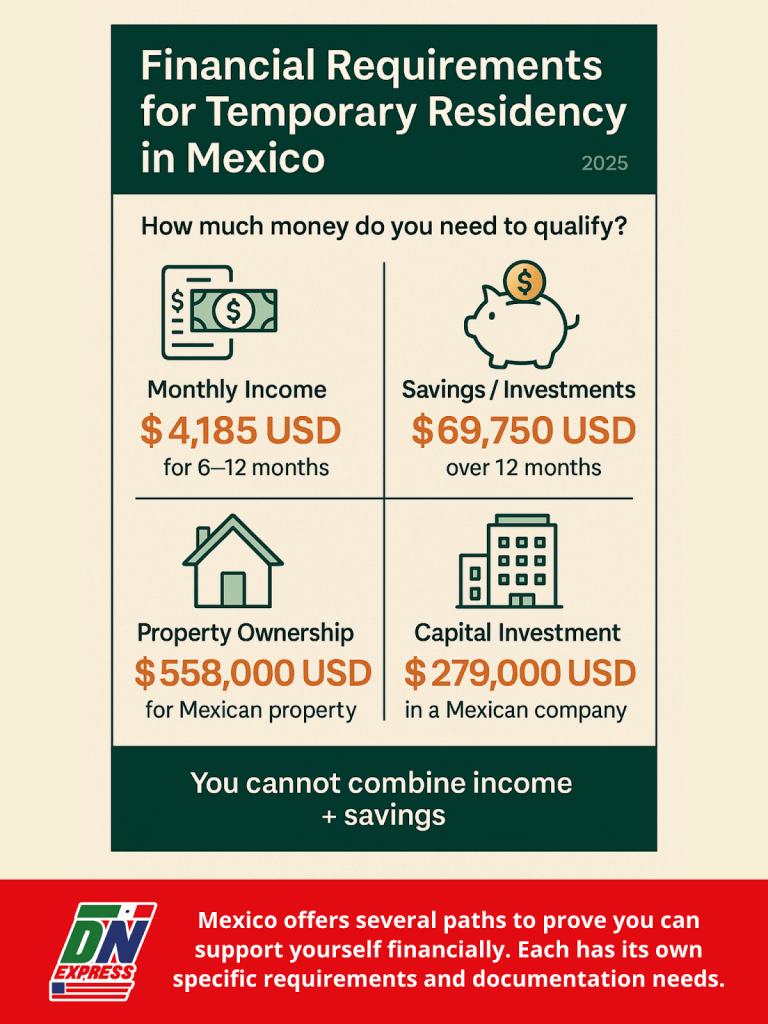
Why You Cannot Mix Methods
You can’t combine partial income and partial savings to meet the threshold.
Consulates require proof of a single qualifying method, and even minor inconsistencies (like one month below the minimum) can derail your application.
How much income do you need for a temporary resident visa in Mexico?
In 2025, consulates typically require $4,185 USD per month for 6–12 months, but some offices use slightly higher exchange rates.
How much bank balance is required for a Mexican visa?
You’ll need to show a 12-month average balance of $69,750 USD in checking or investment accounts. Joint accounts can be tricky, some consulates reject them unless your name appears as the primary holder.
What are the financial requirements for Mexican residency 2025?
Requirements are tied to Mexico’s Minimum Daily Wage (MDW) or UMA (Unit of Measure and Update). Be aware, MDW applies outside Mexico, while UMA applies inside.
This distinction often confuses applicants.
Pro Tip: Consulate Rules Vary
Even with the numbers above, your experience depends on which consulate you use. Some accept printed PDFs of online statements; others demand physical bank stamps or even in-person account logins.
This inconsistency frustrates applicants and causes unnecessary rejections.
Professional services help you avoid these pitfalls by preparing your financial proof to meet the strictest consulate standards, even for difficult cases or past rejections.
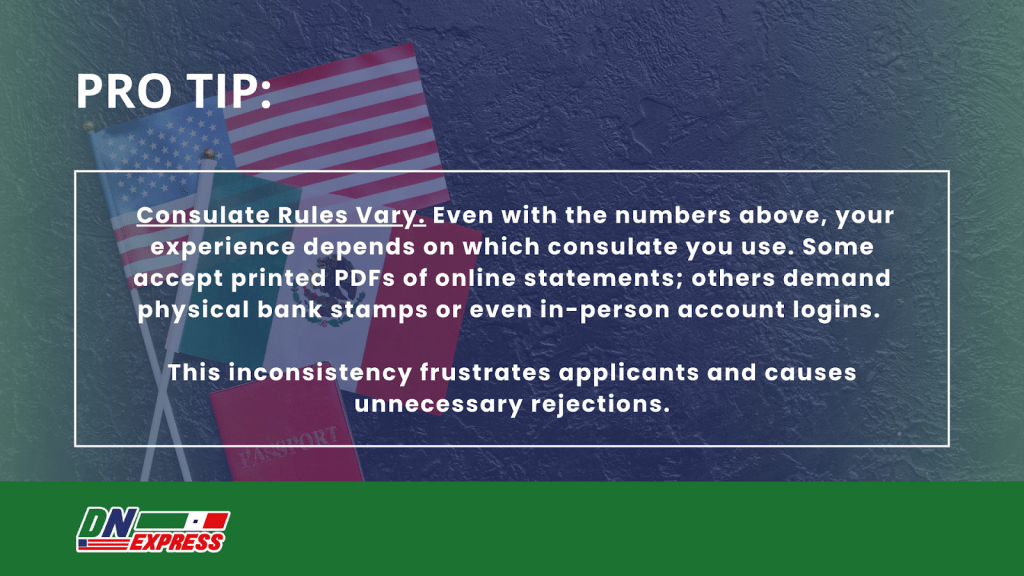
How Financial Requirements Differ Based on Your Situation
While Mexico’s financial requirements for temporary residency seem straightforward on paper, the reality is more nuanced.
Your situation, whether tied to family heritage, previous rejections, or retirement, can dramatically change how consulates evaluate your application.
U.S.-Born Children of Mexican Parents
If you were born in the U.S. to at least one Mexican parent, you often qualify under Mexico’s “Family Unit” rules. This path allows you to reclaim your Mexican nationality without proving economic solvency.
In most cases, your heritage alone unlocks the right to residency or citizenship, provided your parent’s Mexican birth certificate is in order.
However, if there are errors or missing records in your parent’s documents, your application may stall until those issues are corrected, a frequent situation we resolve.
Parents Seeking Dual Citizenship for Their Children
For parents applying to register their U.S.-born children as Mexican citizens, or those considering doble ciudadanía, financial requirements don't typically apply to the children. But the parents themselves must meet income or savings thresholds when applying for their own residency. If you’re including dependents, add 100x UMA (approx. $690 USD) per minor child to your financial proof.
This additional hurdle surprises many families, and is one reason why professional guidance makes the process smoother.

Adults Previously Denied by Consulates
If you’ve been turned away by a Mexican consulate before, expect more scrutiny. Rejected applications often flag your name in the system, and future consulates may demand stricter proof of financial solvency or question past documentation inconsistencies.
We specialize in “impossible” cases like these. Our legal team anticipates consulate variations, prepares airtight financial files, and even handles direct submissions where possible, helping clients overcome what felt like a permanent “no.”
People Correcting Vital Records for Eligibility
Name mismatches, missing parent records, or clerical errors in Mexican birth certificates can prevent you from applying. In these cases, financial requirements are temporarily on hold while the legal corrections are made.
DNExpress often works on document recovery and residency applications in parallel to save months of waiting.
Retirees or Those Planning to Live in Mexico
Retirees often qualify for permanent residency outright, but must show proof of retirement income (like Social Security or pensions) or sufficient savings.
Some consulates ask for official Social Security benefit letters; others accept investment account balances.
Be aware, requirements vary. While Las Vegas and Laredo consulates are known for smoother retiree processes, places like Seattle apply stricter standards and longer wait times.
Key Takeaway:
Your personal situation shapes what financial proof you’ll need, and which pitfalls you might face. We help match your unique case with the right strategy, so you don’t waste time on a path that won’t work.
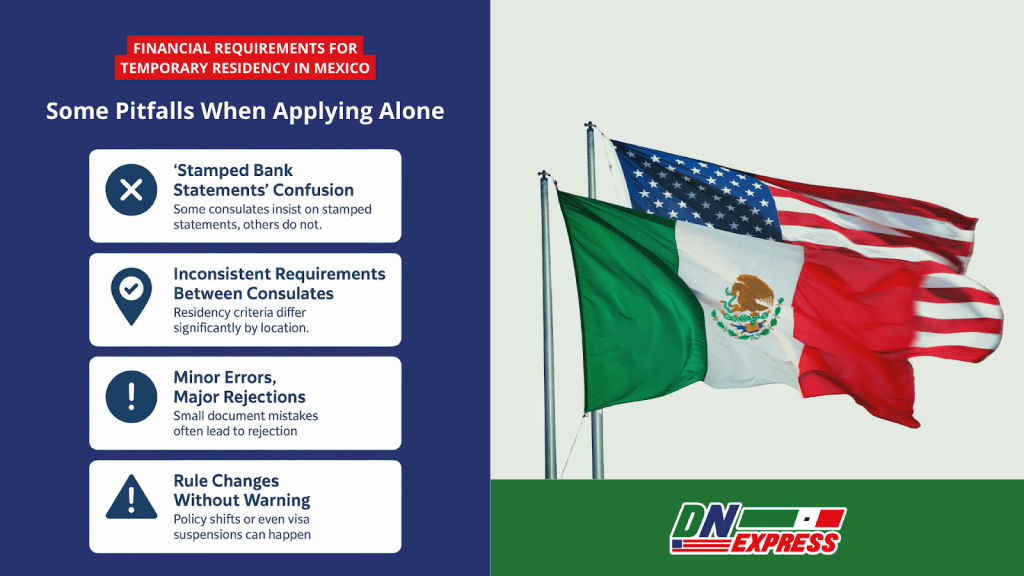
Some Pitfalls When Applying Alone
Many people attempt to navigate Mexico’s residency process by themselves, only to find it’s far more unpredictable than expected.
Here are the most popular mistakes we see (and help fix) every day.
- “Stamped Bank Statements” Confusion
Some consulates insist on original, stamped financial statements from your bank, even in an era where most banks don’t issue them.
Others accept PDF printouts without question. The lack of consistency leads to endless resubmissions for applicants who don’t know which standard applies.
We prepare financial documents that meet the strictest consulate expectations, so you’re never caught off guard.
- Inconsistent Requirements Between Consulates
Think all consulates follow the same checklist? Think again. For example:
- Las Vegas often accepts digital statements and is known for smoother retiree processes.
- Seattle requires applicants to live in their jurisdiction and demands original documents.
- Portland has looser requirements, but only serves residents of Oregon and SW Washington.
This “postcode lottery” frustrates applicants and has led some to relocate temporarily just to apply elsewhere.
- Minor Errors, Major Rejections
Something as small as a mismatched name on your bank account or a one-month dip below the income threshold can trigger a rejection.
For families adding dependents, missing marriage or birth certificates present frequent obstacles.
- Rule Changes Without Warning
Consulate requirements aren’t static, they change with staffing, demand, and internal policy shifts.
One day they accept savings accounts, the next they demand active income. Some offices even pause visa processing entirely without notice.
Key Takeaway:
Doing it alone means risking wasted time, money, and emotional energy.
Our clients avoid these pitfalls because we stay ahead of policy changes and handle all documentation, so your application is rejection-proof.
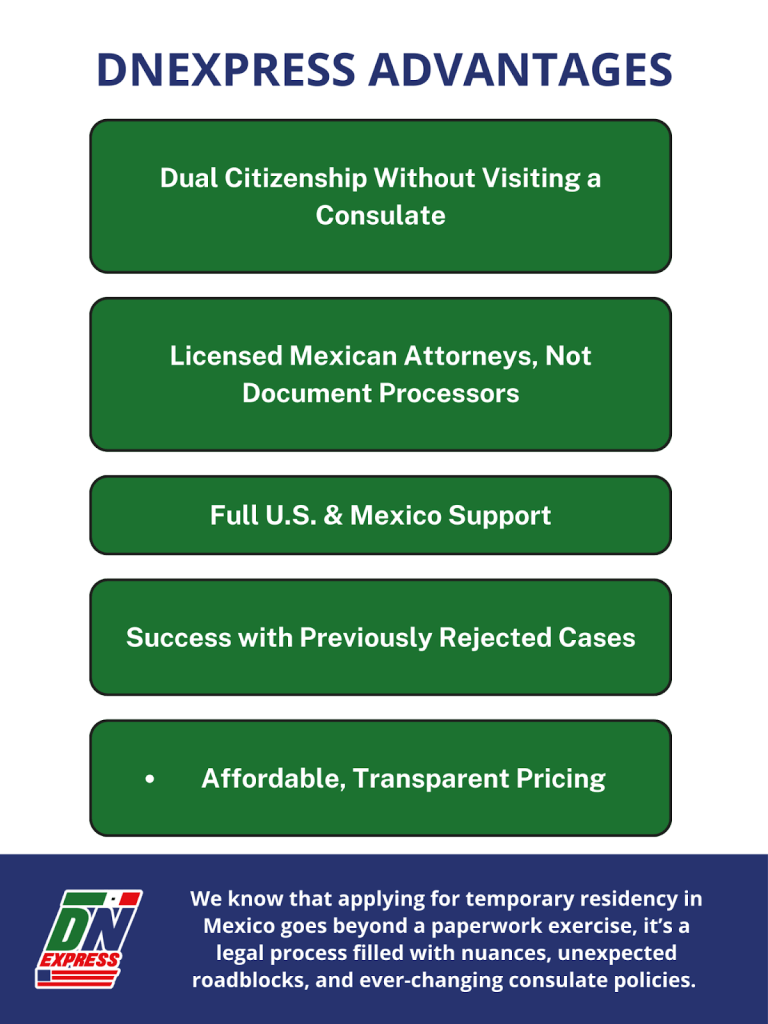
Why Work With DNExpress Instead?
We know that applying for temporary residency in Mexico goes beyond a paperwork exercise, it’s a legal process filled with nuances, unexpected roadblocks, and ever-changing consulate policies.
That’s why thousands of families have trusted DNExpress to guide them safely through it.
DNExpress Advantages
- Dual Citizenship Without Visiting a Consulate
We pioneered remote processing methods that allow eligible clients to secure residency and even Mexican nationality without stepping foot in a consulate.
- Licensed Mexican Attorneys, Not Document Processors
Your case is handled start-to-finish by our binational legal team, not outsourced to third parties.
We resolve complex issues like name mismatches, missing parent records, and prior rejections with precision.
- Full U.S. & Mexico Support
With bilingual agents across every Mexican state, we offer local assistance and fast document recovery no matter where your case hits a snag.
- Success with Previously Rejected Cases
Even if you’ve been turned away before, we know how to present your financial proof and application to pass the strictest scrutiny.
- Affordable, Transparent Pricing
No hidden fees. No surprise add-ons. We even offer flexible payment plans so your path to residency fits your budget.

Downsides of DIY
- Endless Back-and-Forth With Consulates
Every question or missing document can mean weeks, or months, of delays.
- Risk of Privacy Breaches
When applying alone, you may need to share sensitive financial documents with multiple third parties.
We keep all processing strictly in-house for your security.
- Limited Ability to Fix Rejected Applications
We know a denial carries serious consequences beyond simply trying again. Some consulates require you to wait months or even apply in a different jurisdiction.
We know how to avoid rejections in the first place.
With DNExpress, you get peace of mind, legal expertise, and a clear path forward, whether you’re applying for the first time or fighting to overturn a rejection.
How to Apply for Mexican Residency Today
Getting your Mexican temporary residency doesn’t have to feel overwhelming. With DNExpress, the process is simplified into three clear steps:
Step 1: Consulta gratuita
We start with a no-obligation case review. Our attorneys evaluate your situation, including financial eligibility, document status, and any past rejections, and map out the best path forward.
Step 2: Document Review & Correction
From recovering lost birth certificates to fixing mismatches on vital records, our team handles even the most complex legal corrections while preparing your financial documents to meet the strictest consulate standards.
Step 3: Application Filing & Approval
We manage the entire application process, including consulate coordination or direct submissions in Mexico where possible.
You’ll never have to guess about next steps or risk costly mistakes.
Why choose DNExpress?
We go beyond filing paperwork to solve problems that stop most families from achieving dual citizenship or residency.
Whether it’s your first application or a second chance after rejection, we get it done.
Schedule Your Free Case Review or Message Us on WhatsApp Today. Let us help you make Mexico your second home, without stress, delays, or surprises.
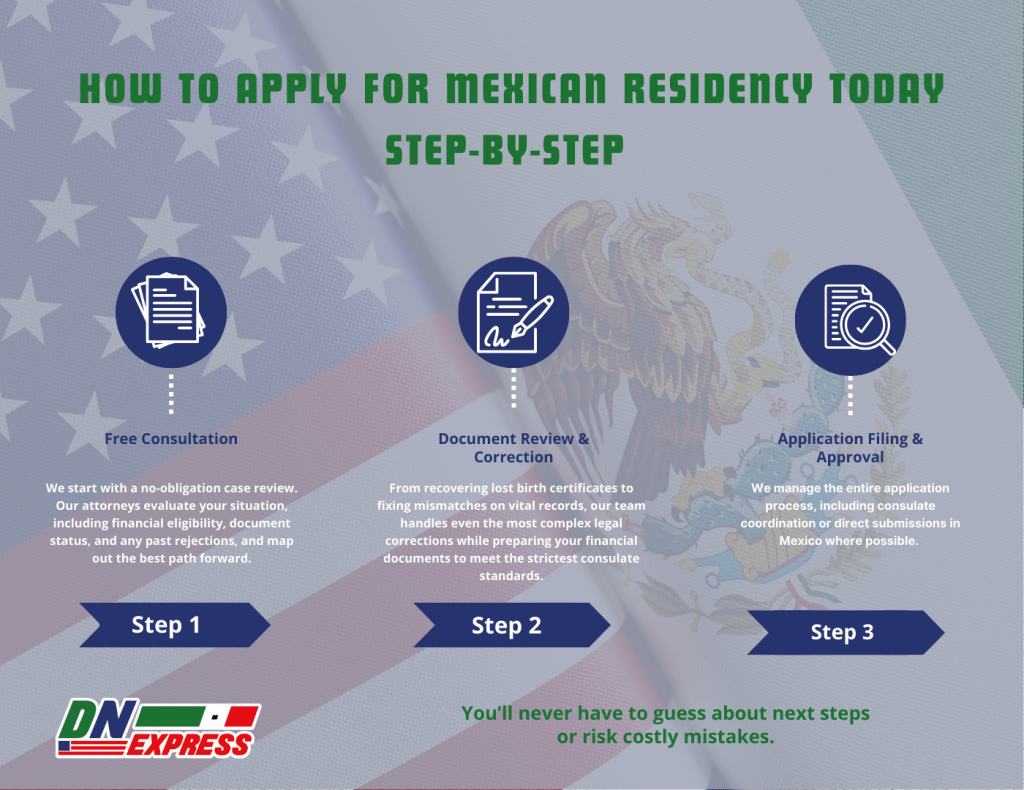
Make Mexico Your New Home Without Stress
Whether you’re a retiree dreaming of sunny days, a parent securing a future for your children, or a professional seeking a fresh start, the path to Mexican residency doesn’t have to feel uncertain.
We’ve helped thousands navigate the complex residency process with clarity, confidence, and zero wasted steps.
From fixing vital record errors to preparing flawless financial proofs, we handle it all, so you can focus on what really matters, building your life in Mexico.
Start your journey today, get clarity, avoid delays, and secure your future in Mexico.
Schedule Your Free Case Review or Message Us on WhatsApp now.
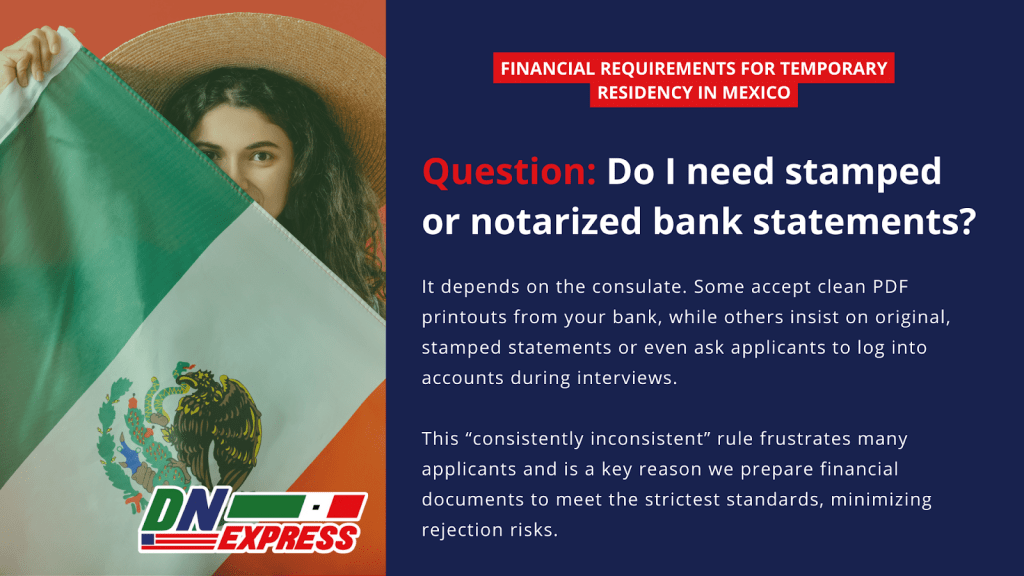
Frequently Asked Questions About Residency Financial Proof
We hear these questions daily from clients unsure how Mexico’s financial rules work. Here’s what you need to know to avoid surprises, and expensive mistakes.
Bank Account & Proof Issues
Can I open a bank account in Mexico with temporary residency?
Yes. Once you’re approved for temporary residency and receive your resident card, most Mexican banks will let you open an account.
Without residency, however, opening a bank account is nearly impossible unless you have strong local ties.
Do I need stamped or notarized bank statements?
It depends on the consulate. Some accept clean PDF printouts from your bank, while others insist on original, stamped statements or even ask applicants to log into accounts during interviews.
This “consistently inconsistent” rule frustrates many applicants and is a key reason we prepare financial documents to meet the strictest standards, minimizing rejection risks.
Do temporary residents pay taxes in Mexico?
Generally, yes, if you spend more than 183 days a year in Mexico, you may become a tax resident and need to file in Mexico on worldwide income.
But tax obligations vary by your situation, and many retirees benefit from tax treaties. Always consult a tax advisor for clarity.
Property as an Alternative
Does buying property in Mexico give you residency?
Owning property alone doesn’t grant you automatic residency.
However, if the property is debt-free and valued at $558,000 USD (40,000x UMA) or more, it may be used to meet financial requirements for a temporary residency application.
Why property-based applications are rare and complex
This route requires official appraisals, notarized deeds, and legal representation to prove value.
Even then, not all consulates recognize property as sufficient economic solvency.
We only recommend this path in specific cases where it’s legally viable.
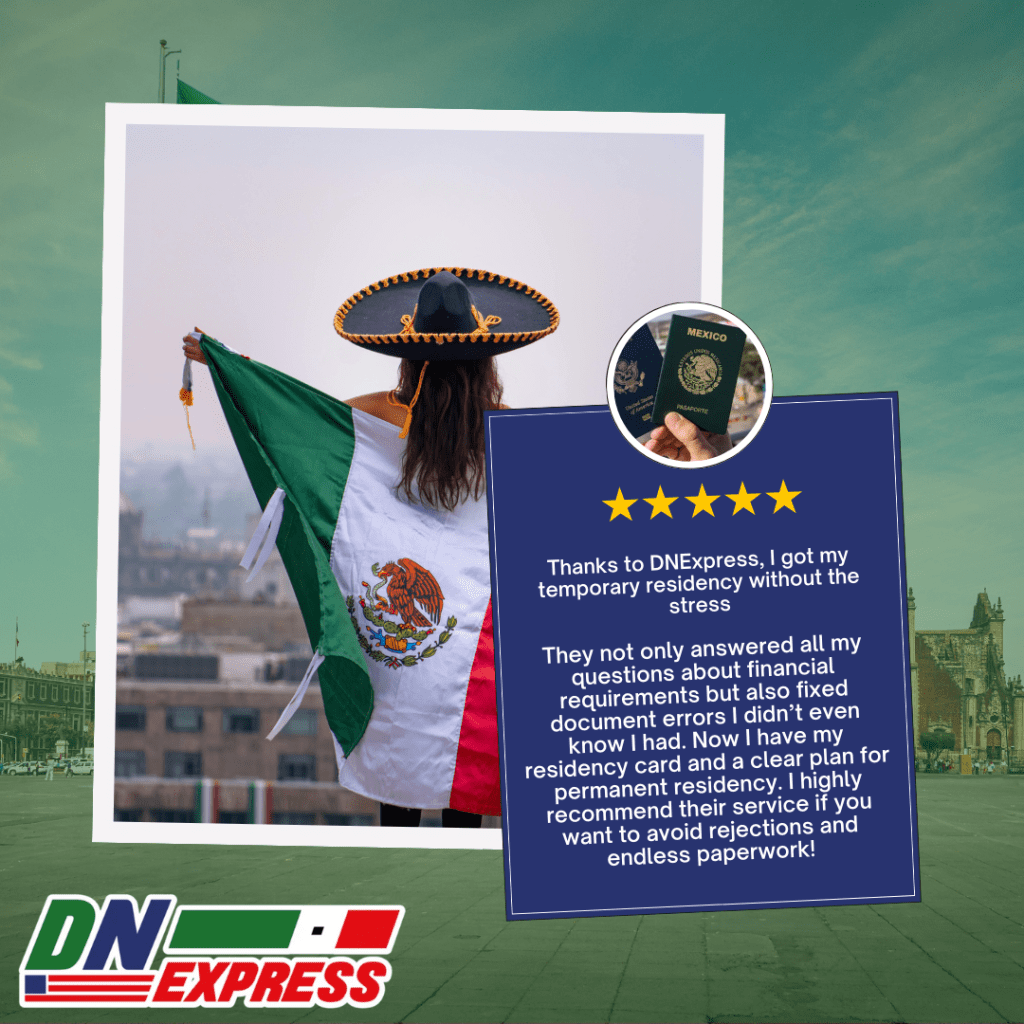
Cost of Residency
How much does it cost to become a temporary resident in Mexico?
Expect to pay between $300–$600 USD in government fees for the application, plus additional costs for document translations, notarizations, and photos.
Hidden fees to plan for:
- Certified translations of foreign documents ($30–$50/page)
- Notarizations for birth/marriage certificates
- Apostilles (if required)
- Transportation for consulate visits
Many DNExpress clients save time and avoid hidden fees by using our remote application service, no flights or consulate appointments required.
Pro Tip: Before submitting your financial proof, check for minor inconsistencies like account holder names or currency conversions. Even small errors can lead to rejection at certain consulates.



